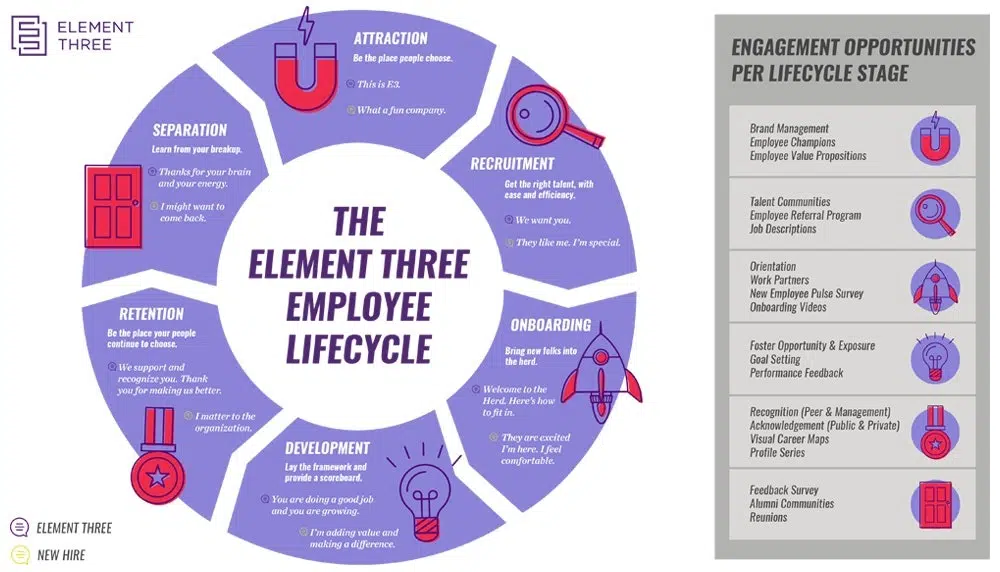When people ask me what my job is, I typically respond by saying that from the very first moment a candidate engages with us to the time they exit our company (and even beyond, in some cases), I am responsible for their experience and for their well-being. Yep, that’s a lot of pressure and I don’t take it lightly.
That relationship could be very short in that they apply for a job that we do not hire them for, or it could last for a decade as they spend a good part of their career with us. Regardless, it is my job to ensure consistency and quality in their experience.
Believe me, this is not a “fly by the seat of your pants” process. Well, I guess it could be, but I don’t recommend it. Putting the work in and really studying your company’s employee lifecycle (which can also be referred to as the employee journey) in detail has paid off for us in spades.
Understanding the Employee Lifecycle
What are the critical steps along the path that a person takes from start to end in their relationship with your company? And how do you ensure clarity, consistency, and quality at each of those stages?
There is, of course, a framework of these standard steps that exists at any company, and your employee lifecycle is a great place to start. You can dive deeper into any of these areas or add more steps that make sense for your business. And while yours might look a little different, here’s how we mapped ours out.
An example of the employee lifecycle at Element Three
Attraction
Be the place people choose. Outsiders are thinking, “What a fun company.”
Recruitment
Get the right talent with ease and efficiency. Prospects are thinking, “They like me. I’m special.”
Onboarding
Bring new folks into the Herd. New hires are thinking, “They are excited I’m here. I feel comfortable.”
Development
Lay the framework and provide a scorecard. E3ers are thinking, “I’m adding value and making a difference.”
Retention
Be the place your people continue to choose. E3ers are thinking, “I matter to the organization.”
Separation
Learn from your breakup. E3 alumni are thinking, “I might want to come back.”
Mapping these out for your current and potential employees will provide a clear path or guide throughout their time with you. Personally, I use this guide in our recruitment process to establish trust with the candidate by providing them with a look inside our world while demonstrating to them that we have thought all of this through and we have a plan.
There are two issues in particular I’d like to address in this blog post. One is how mapping out your employee lifecycle helps you attract talent, and the other is how it helps you retain talent. Let’s take these one at a time.
Talent Attraction
One of the most attractive traits that potential candidates look for when seeking to make their next career move is clarity around what to expect. Clean lines, documented processes, and key indicators from the company that demonstrate they have a plan for talent engagement and retention are high on the list of anyone looking for a place to settle down.
Consistent messaging and explanations of these processes during the interview process are key. If the interview experience leaves them confused because the answers to their questions were all different depending on who they were talking to, clearly there is a disconnect on what is really going on.
Having a clearly documented and implemented employee journey, based on their lifecycle, puts you at the front of the line in securing that talent quickly and consistently.
Take the time to map it all out. And I don’t mean just a pretty picture like the one above (though that doesn’t hurt). I mean a guide. A document that lays it all out in front of them. A guide that lives and breathes in your organization, and is not just created and used for recruitment but is used internally to continue to inform your employees on their own journey long after they start their tenure with you.
Here is an example of what the lifecycle of a new employee might look like:
Onboarding Mentor
Works with them for the first four weeks to simply acclimate them to the culture and environment.
30-day Check-in
With HR, to make sure things are on track and going well.
90-day Review
With their supervisor, to level set on workload, resources, or support needed, and how things are going.
100-day Check-in
With HR, to kick off the development plan process and ask for feedback on our onboarding process.
Talent Retention
The quickest way to lose top talent is to sell them a facade—once they get inside the doors, they’ll discover it was all bait. In reality, you don’t really practice what you preach. Here’s a little hint. Don’t BS your talent. They are way too smart and marketable for that. And so are your current employees. If they see you selling something to incoming talent that they know isn’t true to form, you now have a whole other issue of trust and retention to deal with.
Today’s savvy buyers have gotten used to being scammed. We have all become very cynical consumers of both goods and information. The photos on the website are not to be trusted. We need to hear the real deal from your real customers (in our case, past and present employees) before we buy.
Having a solid employee lifecycle that holds true all the way through the journey—from candidate to veteran employee—has tremendous worth. Think about it. A new employee coming into the company is set up for success because they know exactly what to expect from an onboarding, the first 100 days, and feedback perspective. What am I doing? What happens next? How am I doing?
Once those first 100 days are complete, the lifecycle continues with a clear outline of what to expect going forward. Development plans, the performance management process, etc. How do I continue to improve? What do they want from me? How am I doing now?
No Surprises
If your systems are clear and consistently practiced, and if your leaders are coached and trained on the implementation of said systems, your employees should spend zero energy on wondering or worrying about how they are doing. And with a robust communication framework, employees are basically guaranteed to know whether they’re performing up to standards. Here is a framework of what I mean by this:
- Daily: Constructive feedback and praise for good work “in the moment.”
- Weekly/Bi-weekly: 1:1 interaction with your manager. What are your priorities, how can I help?
- Monthly: Development plan progress review.
- Quarterly: Peer feedback process.
- Bi-annually: Performance assessment with direct supervisor.
- Annually: STAY interview (why do you stay?), compensation review.
Clarity Is Key
Even the most independent, risk-taking, visionary personality requires a road map to be successful. Don’t waste time making your candidates or your employees feel around in the dark in order to find their way. Pay attention to the employee lifecycle from start to finish. This allows your candidates to make an informed decision about joining your team, and it gives your current employees clarity about what comes next and helps them answer the question, “why should I stay?”
This article originally posted on the Powderkeg blog.





